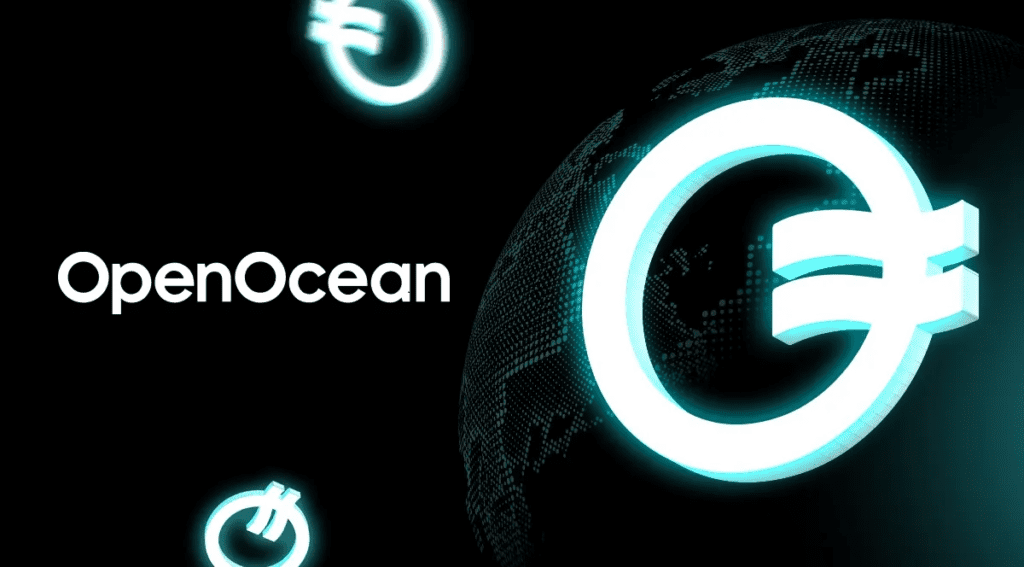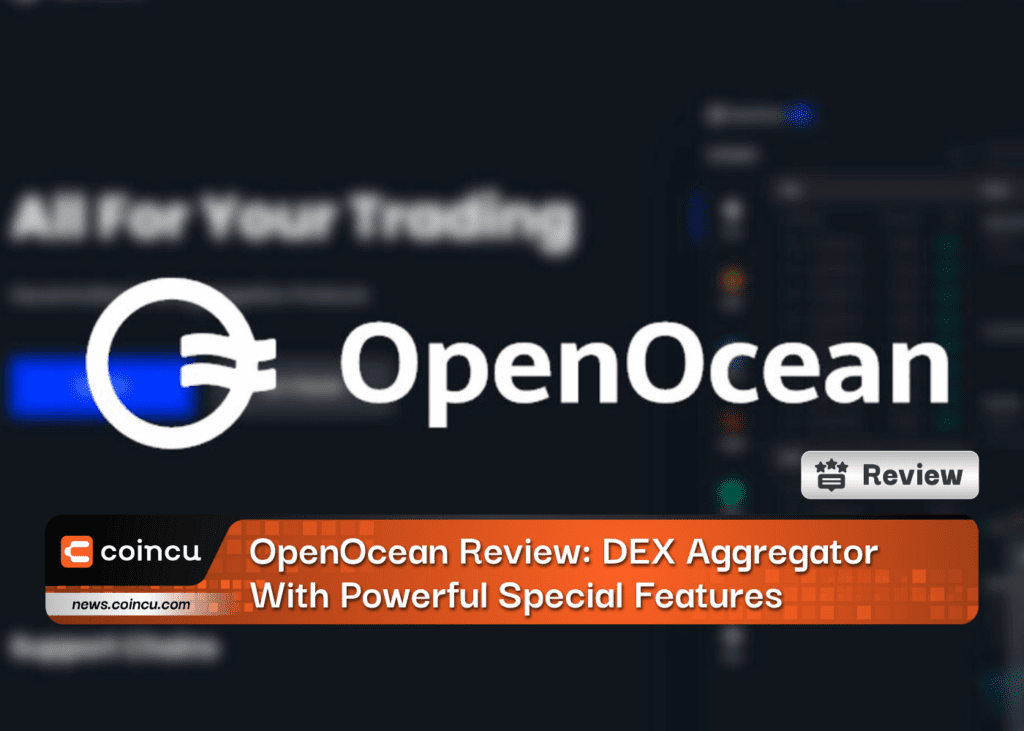Aggregators, such as OpenOcean, refer to many platforms, enabling customers to access the liquidity and pricing of several exchanges at the same time, allowing them to discover the best rates and lowest costs for their transactions. It is a multi-chain exchange that works as a bridge between centralized and decentralized money. Let’s learn details about this project with Coincu through this OpenOcean Review article.

OpenOcean was created to address a major difficulty in the crypto market: integrating liquidity so that transactions are simple, with minimal spreads, and as quick as possible. To learn more about OpenOcean, its benefits, how it works, transaction costs, investors, team, and project plan, go here.
What is OpenOcean?
OpenOcean is a DEX aggregator that pools liquidity from different DEX and CEX markets to enable optimum purchasing. The most notable aspect of OpenOcean is that it develops cross-chain on numerous platforms, including Ethereum, BNB Chain, Ontology, and Tron, allowing users to avoid having to access multiple platforms. In the future, the project hopes to build on Solana or Polkadot.
Users may benefit from competitive trading prices and decreased slippage since it unites the list of centralized and decentralized exchanges. Now, the OpenOcean Review article will provide highlights of the project.
Highlights of the DEX aggregator
OpenOcean has a few key characteristics that allow it to effectively serve its consumers. Its optimizing algorithm, which is based on Dijkstra and D-star, finds the optimal starting path for users, providing the best fills and gas prices. The program then uses machine learning to continually optimize routes based on data. This method allows for accurate and efficient aggregation without charging consumers exorbitant costs.
Token Economic Subsidies are an OpenOcean-developed solution for reducing users’ temporary loss via slippage subsidies. This protects consumers when their exchange value is more or less than the transaction’s anticipated value. If the user’s exchange value is more than the predicted value, the user will be completely repaid. When a transaction has a lower-than-expected value, users are compensated with the platform token, OOE.
Moreover, the team has released the OpenOcean DeFi Evaluation System (ODES), an asset appraisal mechanism. To safeguard users, the system assesses tokens based on risk exposure using a large quantity of ecological data. To be available for trade, tokens must meet “low-risk” conditions. This serves as a preliminary screening method, adding an additional degree of protection for OpenOcean customers.
Ultimately, the team seeks to assist all traders by being a one-stop trading destination for all assets. This means that OpenOcean Wallet users will be able to trade on centralized platforms like Binance, Coinbase, and Bitfinex.
OpenOcean is also attempting to add derivatives platforms by using a portfolio margin pool. OpenOcean delivers APIs and custom-fit UIs to make it easy for users to access their front end. To give the greatest tools to its traders, OpeanOcean is already developing a totally new UI/UX. Generally, the team hopes to develop further since they now only provide aggregation to spot and DEX dealers.
The most outstanding feature of the platform is that the platform not only aggregates liquidity from DEXs but also aggregates liquidity from CEX. Also, OpenOcean not only integrates one chain but integrates a lot of chains compared to other platforms.
In the future, it will have a very strategic direction when providing not only Spot/Swap trading products but also derivatives trading, borrowing/lending, and insurance products.
Its special features are summarized as follows:
- OpenOcean has already collected approximately 20 popular DEXs, including ETH, BSC, Tron, and ONT. During trading, provide the best price and minimize slippage.
- Cross-chain support: Via Binance Bridge, the DEX aggregator now allows cross-chain transactions between BSC, Ethereum, Polygon, and other chains. OpenOcean enables you to withdraw money from any chain to your wallet from your account.
- Trading aggregation connects DeFi and CeFi: After analyzing pricing and liquidity, users may freely select to trade on DEX or CEX with the best price.
- Synthesis of derivatives, loan, and insurance products: To offer derivatives trading services, it will combine Cefi derivatives and DEFI derivatives trading platforms. It will also combine loan and insurance goods and deliver smart investing services.
- Complete user coverage: The platform will support both DeFi and CeFi users. Help for both new and experienced traders.
- Simple interface: An important feature of OpenOcean is its simple interface. Users may utilize various cryptos on the same interface in the Classical edition, which offers a generic exchange feature. Moreover, the Professional edition enables direct trading as well as the creation of a Crypto trading wallet without the need for identification verification.
- OpenOcean offers APIs, trading tools for derivatives of both DeFi and CeFi liquidity, profit and loss setting, limit orders, charting tools candlesticks for quick price monitoring, insurance services, and support for standard wallets.
Features of OpenOcean
Option Trading
Traders on DEXs and CEXs may personalize the user interface to ensure they don’t miss any important information.
Limit orders and candlestick chart tools, profit and loss management, timely monitoring and reminders, and bespoke APIs with customized user interfaces are all accessible trading strategy tools.
Individual investors may utilize a simple interface to make spot and derivative transactions at the best possible price with the least amount of slippage.
Increased Liquidity
To offer transaction depth and a speedier reaction time, OpenOcean combines liquidity from major DEXs and CEXs. Wallets from the mainstream are supported. With the OpenOcean portfolio margin pool and wallet, you may conduct one-stop transactions on any CEX. Using clever routing and machine learning, they provide the best pricing and the lowest slippage gas costs. For protocol routing, they use an optimized form of the Dijkstra Algorithm (D-star).
Arbitrage
OpenOcean can help you detect price disparities between CEXs and DEXs as well as arbitrage possibilities. You may also discover a thorough guide to arbitrage on OpenOcean.
OpenOcean Classic
It’s a straightforward platform for switching in DEXs. They support more token pairs than the Pro version.
OpenOcean Pro
It is a sophisticated arbitrage and exchanging tool with chart assistance. They also want to provide derivatives, loans, and insurance.
OOE Token
The majority of DeFi projects issue their own tokens, and OpenOcean is no exception. On March 8, 2021, the project launched its native token OOE, with 1 billion tokens. Within the OpenOcean ecosystem, the OOE token fulfills multiple functions. It’s a governance token that allows holders to vote on various OpenOcean-related topics.
OOE holders also benefit from lower transaction costs as a result of gas charge reductions and slippage subsidies offered by OpenOcean during special campaigns. The currency may also be used to mine liquidity on the OpenOcean platform. While employing OpenOcean’s centralized exchange aggregation capabilities, users that hold a considerable quantity of OOE will profit from a variety of advantages.
OpenOcean distributed 10 million OOE tokens (1% of total supply) to users who have completed at least four valid OpenOcean transactions or conducted a transaction worth more than 40 USDT between the platform’s debut and March 8, 2021. Individuals who did not get the initial airdrop may be eligible for a second round. This possibility provides an extra incentive for those who have not yet traded on OpenOcean to do so.
Key Metrics
- Token Name: OpenOcean token
- Ticker: OOE.
- Blockchain: Ethereum, BSC, Avalanche, Polygon
- Token Standard: ERC20, BEP20, ARC20, PRC20
- ETH Contract: 0x7778360f035c589fce2f4ea5786cbd8b36e5396b
- BSC Contract: 0x9029fdfae9a03135846381c7ce16595c3554e10a
- Polygon Contract: 0x9d5565dA88e596730522CbC5a918d2A89dbC16d9
- Avalanche Contract: 0x0ebd9537A25f56713E34c45b38F421A1e7191469
- Token Type: Utility
- Total Supply: 1,000,000,000 OOE
- Circulating Supply: 504,425,832 OOE
Token Allocation
- 5.6% is given over a two-year period to strategic investors who are working with the project
- 7.5% for private placement and strategic round two over 2.5-3 years
- Over three years, OpenOcean Lab and co-builders will save 29% on protocol development, onboarding value-added ecosystem partners, community developers, and bounty programs
- 33% over five years to attract future liquidity providers and motivate users
- 7% over three years to ecosystem co-builders that oversee OpenOcean ecosystem development, community incentives, campaigns, and so on.
- 15.9% for the team and advisers over three years
- 2% to early users, distributed upon the token issue.
Fees
It doesn’t charge any transfer fees or withdrawal costs other than the network fees. Fees are assessed in the four situations indicated below:
- Products with a Combined Margin.
- Service for intelligent money management.
- Institutional investors pay to have an investing plan shown on their custom-built user interface.
- Primary Membership Edition (PME) is a SaaS that automates the capture of arbitrage possibilities between CEXs and DEXs.
Core team
The OpenOcean team consists of engineers and senior ex-employees from the industry’s largest financial exchanges and international technology organizations, including IBM, Intel, and HP.
Michael “Monty” Widenius, the spiritual father of MariaDB and one of the original developers of MySQL, and Tom Henriksson, who invested in MySQL and MariaDB, co-founded the project. Both of OpenOcean’s co-founders have substantial expertise in the creation of investing and trading platforms.
The development team at OpenOcean comprises of 16 full-time workers with extensive experience in blockchain development. The primary components of the development team are seasoned engineers and finance veterans from major industry exchanges and multinational IT organizations such as IBM, Intel, and HP.
Investors and partnerships
Investors
The project has also collaborated with important firms to improve the capabilities of trading features and provide crypto enthusiasts with a diverse variety of investment possibilities.
According to a press statement, OpenOcean has closed a financing round in which Binance participated as a strategic investor.
So far, OpenOcean has invested more than $2 million in two rounds, with several significant investment funds in the market participating.
Investors in the private round include Altonomy, AU21, TRON Foundation, FBG, Asymmetries Technologies, DAO Maker, LIAN Group, and Block Dream Fund.
Binance led the strategic round, which was also attended by Kenetic, Multicoin Capital, CMS, and LD Capital.
Partnerships
OpenOcean’s current partners include DeFi and CeFi exchanges from the cryptocurrency industry, including Uniswap, Sushiswap, Balancer, and even Binance. This enables the DEX aggregator to offer liquidity at the best feasible price.
Conclusion of OpenOcean Review
The OpenOcean aggregator covers a wide range of bitcoin markets. The platform will provide actual value to bitcoin users of all levels by supporting four various blockchains and 13 different wallets. It enables users to rapidly and effectively trade tokens in order to get the best fill and lowest gas costs. The aggregator system is completely free to use, and traders simply pay the standard blockchain gas and exchange costs.
Considering its potential benefits, OpenOcean will grow rapidly in the future. The disadvantage is that tokennomic has yet to make a breakthrough. Hopefully the OpenOcean Review article has helped you understand more about the project.
DISCLAIMER: The Information on this website is provided as general market commentary and does not constitute investment advice. We encourage you to do your own research before investing.
Join us to keep track of news: https://linktr.ee/coincu
Harold
Coincu News





